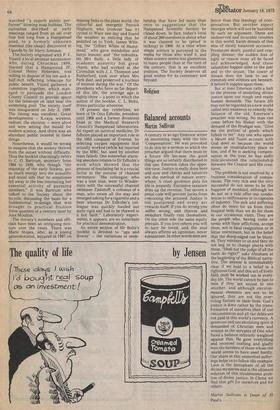Science
Hampstead charms
Bernard Dixon
The Hampstead Scientific Society has just published a splendid little booklet chronicling its doings and personalia, both eminent and amateur, over three-quarters of a century. It is written with a charm and serendipity characteristic of a society that, over the years, has heard first hand about momentous discoveries by the world's top scientists, as well as listened to "E. C. Crump, the bank manager" lecturing on "Nature's Forces" and
watched "a superb public performer" blowing soap bubbles. The curiosities described at early meetings ranged from an eel over four feet long from a Hampstead pond, to a formerly unknown mammal (the .okapi) discovered in Uganda by Sir Harry Johnson.
The Society originated with P. E. Vizard, a local amateur astronomer who, during Christmas 1898, learned that a Hampstead JP, Colonel Henry Heberden, was willing to dispose of his ten-and-ahalf-inch reflecting telescope for public benefit. Vizard gathered a committee together, which managed to persuade the London County Council to provide space for the telescope on land near the swimming pool. The society itself was inaugurated on July 3, 1899. The timing was excellent. Great developments — X-rays, wireless, radium, the electron — were afoot and were setting the mould for modern science. And there was an abundant public interest in these things.
Nonetheless, it would be wrong to imagine that the society thrived from the outset without difficulty. Thus the booklet charmingly refers to C. 0. Bartrum, secretary from 1904 to 1930, who though "the mainstay of the early Society, put so much energy into the scientific and social side that he sometimes fell away in the less interesting but essential activity of pursuing members." It was Bartrum who talked to the Society about the bicycle, discussing the basis for a fundamental re-design that was brought to practical fruition three-quarters of a century later by Alex Moulton.
The Society's members and officials have been an intriguing mixture over the years. There was Marie Stopes, who, as a young palaeobotanist, lectured in 1907 on missing links in the plant world; the colourful and energetic Patrick Hepburn, who (rumour has it) cycled to Ware one day and found the weather so enticing that he pedalled on to York; James Wh'iting, the "Gilbert White of Hampstead," who ,gave mandoline and banjo lessons; and "the redoubtable Mrs Baily, a little lady of academic austerity but great charm, who had worked at the Cavendish with J. J. Thomson and Rutherford, took over when Mrs Park died, and preserved a nucleus of interest during the war." Of the presidents who have so far departed this life, the average age is eighty-three — a point to which the author of the booklet, C. L. Boltz, draws particular attention.
Of present day celebrities, we learn of Dr Otto Edholm, president until 1968 and a former divisional head at the Medical Research Council's Hampstead laboratories. An expert on survival medicine, Dr Edholm played an important role in the 1953 conquest of Everest, by selecting oxygen equipment that actually worked (while kit rejected by the MRC but used by another team failed). One somewhat alarming anecdote relates to Dr Edholm's work which showed that the amount of insulating fat is a crucial factor in the success of channel swimmers: "His colleague, who was a lean man, went to Windermere with the successful channel swimmer Zadonoff, a colossus of a man, who swam all the way and emerged asking for a cigarette and a beer whereas Dr Edholm's colleague was quickly hauled out quite rigid and had to be thawed in a hot bath." Laboratory experiments, it appears, are no substitute for practical demonstration.
An entire section of Mr Boltz's booklet is devoted to "ups and downs" — the variations in mem bership that have led more than once to suggestions that the Hampstead Scientific Society be closed down. In fact, today's total of about 200 members is about what it was claimed to be (proof is lacking) in 1900. At a time when ample science is purveyed in the media for those who want it, and when science seems less glamorous to many people than at the turn of the century, that is an excellent position. The Society deserves all good wishes for its centenary and beyond.



































 Previous page
Previous page